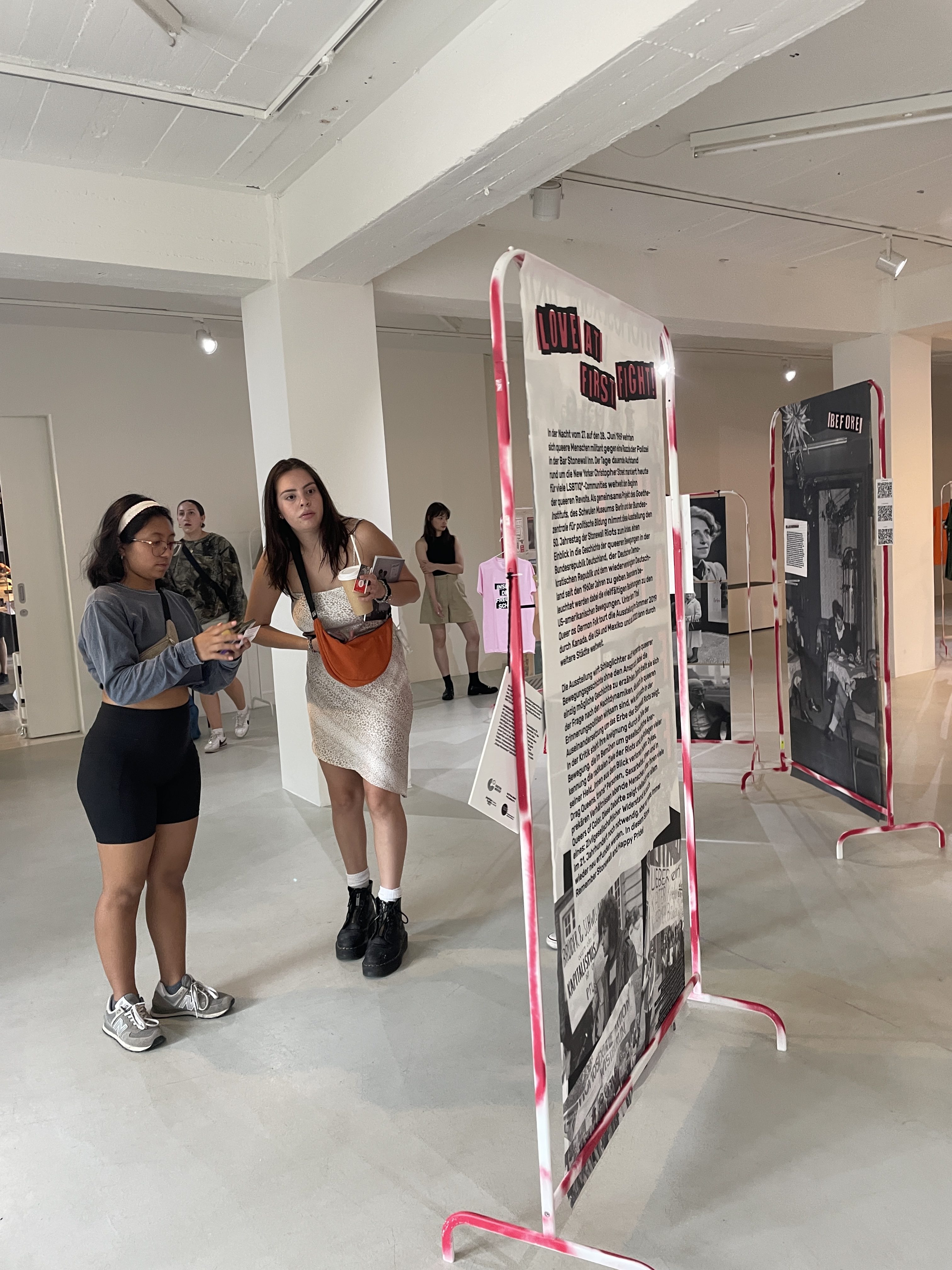
Brailey Harris
On our last Monday as the #FemGeniusesinBerlin, we had class at our usual spot, xart splitta on Hasenheide Street. After our initial check-in, we got to hear about Judy’s research on Indian hobbyism in Germany and its implications. Throughout our discussion, Judy gave us insight into the academic journey she has followed as her understanding of and relationship to this prominent industry has shifted. As we wrapped up class, I asked Professor Lewis a question about the generation and perpetuation of knowledge. “How do you decide what stories you share with the community, the public, and what you keep to yourself?” In her response, she reminded me that with whatever I choose to share, I should leave room for my future self to disagree with me. As you age, the perspective you have on the work you do will likely change. After class, I headed to the Schwules* Museum to learn about the queer histories of Berlin. With white faces abound, I saw friends, lovers, and colleagues, but I struggled to find myself represented in this space– except in a small but powerful exhibit dedicated to Audre Lorde, Katharina Oguntoye, and Showing Our Colors: Afro-German Women Speak Out. I did, however, notice what looked like remnants of New York style Ballroom culture in the drag queens’ dress and performances depicted on the walls. This leads me to the question: “How is Black culture within the United States reproduced elsewhere?” I ended my day with a visit to the Berlin Aquarium. As a giant Ecology nerd, I have been very curious to know more about how Berliners memorialize, preserve, and protect the nature that surrounds them. The tortoises and lizards were more friendly with visitors than I have ever witnessed, and I got to see insects I have only ever heard about in books!
Brailey Harris is a rising sophomore at Colorado College and a Texas native. They enjoy slam poetry, speaking out of turn, and playing rugby for the school’s Cutthroat Trout club team. Brailey’s major is currently undeclared, but they hope to intertwine their passions for understanding both people and the planet.
This slideshow requires JavaScript.

Elie Deshommes (middle) with Kate Nixon (left) and Elliot Triplett (right)
My day in the life was an interesting one. I went to the Schwules* Museum and the Berliner Medizinhistorisches Museum der Charité (the Gay Museum and the Medical Histories Museum). Medical history has always been a topic of interest to me. From the humor of Ancient Greece to the “bad airs” of the Victorian period, humanity has come a long way in understanding what makes our bodies tick. However, what most fascinates me is the study of race, body rights, and the extent that these beliefs affect us today. The Medical Histories Museum acknowledged the shaky history of its early collections, noting that most wet and dry specimens were taken from the most vulnerable in society (e.g., mentally ill, unwed mothers, and poor people). Quite simply, these people were only seen as valuable in terms of what could be taken from them. Walking around and seeing the early specimens was a painful process. They had no names, and their anonymity in life continued in death. Female, Male, Adolescent, and many other labels were attached to them—all but the names that gave them identity. Seeing the phrenological skull and the journals on phrenological and racial typecasting made me ache. Before me was the justification and the works that were utilized in the slave trade, genocides, and many other systems of racial hate. The museum did a good job in acknowledging the criminality of these “doctors” and “scientists” with an entire section on how false science and racism influenced the results and the methods that were used to gain these results. But what made me hopeful was the museum’s focus on giving body rights and names back to the patients they cared for (in the connected hospital). From the 1920s onward, consent was a major element of the specimens. Other visitors didn’t enjoy the fact that the specimens had names and stories behind them, but for me it was refreshing. Their bodies weren’t stolen and abused. They were given freely with the goal to further medical understanding. It isn’t a perfect system. Classism, sexism, and racism are still very present in the modern day. For example, Black people are still often seen as patients without pain and without needs. The mentally ill are still treated with scorn and discomfort. But what I saw in that museum (and the adjacent studies in the Neuroscience Division) was a focus on the individual, a practice focused on truly helping others, caring about them, and letting the patient have their individuality and names back.
Elienne Deshommes is a queer rising junior who loves to learn. They are majoring in Organismal Biology, focusing on environmental stability and healing. However, their interests are broad and include African-based religions, queer history, evolutionary sciences, and Greco-Roman history. Born in Denver, CO to a Haitian immigrant father and a Coloradan mother, their dream would be to return the island of Hispaniola and its ecological past to increase the opportunities of LGBT citizens via STEM jobs and education.
This slideshow requires JavaScript.














